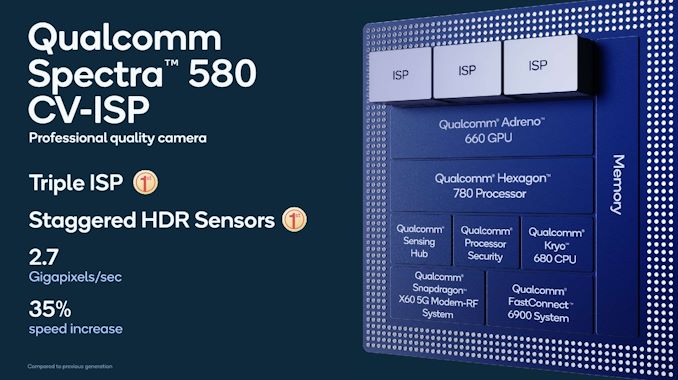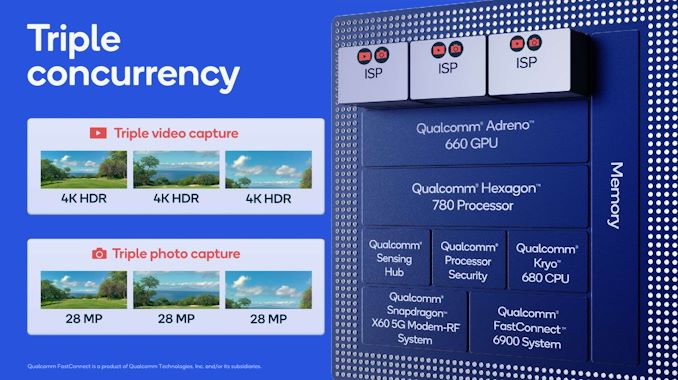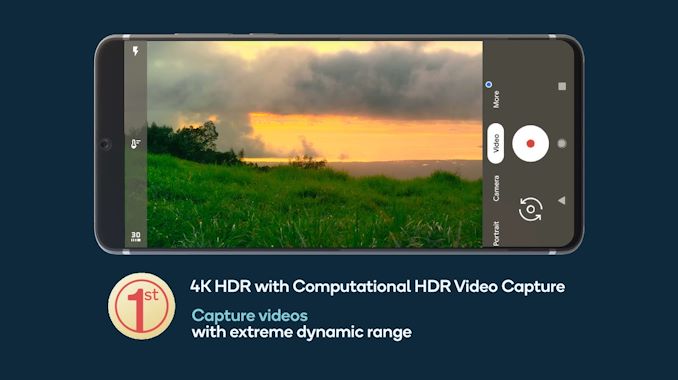Qualcomm Details The Snapdragon 888: 3rd Gen 5G & Cortex-X1 on 5nm
by Andrei Frumusanu on December 2, 2020 10:00 AM EST- Posted in
- Mobile
- Qualcomm
- Smartphones
- SoCs
- 5G
- Cortex A78
- Cortex X1
- Snapdragon 888
Triple ISPs: Concurrent Triple-Camera Usage
Interestingly enough, during yesterday’s keynote event, Qualcomm described themselves as a camera company, which is a funny way to see things, but actually somewhat makes sense given the large leaps in smartphone camera capture capabilities over the recent years.
The new Snapdragon 888 pushes the envelope in terms camera abilities by adding a whole new independent third ISP to the SoC, allowing the SoC to now run three independent camera modules concurrently, opening up new use cases for vendors and camera applications.
The new triple-ISP architecture now increases the overall pixel processing throughput by 35% to 2.7Gigapixels/s, allowing for concurrent usage of up to three 28MP sensors with zero shutter lag captures. Alternatively, you can use a combination of 64+25MP sensors with ZSL, or a single 84MP sensor with ZSL. There’s still also support for ultra-high-resolution sensors up to 200MP, but image captures here don’t support ZSL.
Allowing concurrent captures of three sensors now allows for the holy trifecta of ultra-wide-angle, wide-angle and telephoto modules to capture a scene at the same time, allowing for more interesting use-cases such as image stitching and image fusion to happen to seamlessly.
One interesting capability that Qualcomm was advertising is triple-stream 4K HDR video recording. That’s a bit of an odd-ball use-case as I do wonder about the practical benefits, but I do at least hope that the new triple ISP system allows for more seamless switching and zooming in and out between the various camera modules during video recording.
Video recording capabilities this year don’t seem to have changed, compared to the Snapdragon 865. This means 4K120 or 8K30 are still the peak capture modes, supporting also slow-motion of 720p960. Formats are also unchanged, with HEVC encoding in HDR formats such as HDR10+ or Dolby Vision being supported.
AV1 decoding didn’t make the cut this year unfortunately, which means wide-spread adoption in mobile for the codec will be delayed for another year.
While the video encoding formats haven’t changed, the image processing capabilities for HDR capture has. Thanks to the new ISPs and the raw performance throughput, the new Snapdragon 888 will be able to capture 4K HDR footage with the more advanced computational HDR processing being applied on each and every frame of the video.
Qualcomm claims that the new ISP in the Snapdragon 888 is the first to support new next-generation staggered HDR sensors.

Source: OmniVision
These are sensors that can have multiple rolling shutters, meaning sensor line readouts, active at the same time on the sensor. Instead of taking multiple exposures one at a time sequentially by scanning out the sensor matrix from start to finish, the sensor will start another exposure immediately after the completed line read-out, reducing the time in-between exposures greatly. This should allow for significant less motion ghosting between the exposures and a sharper resulting recombined HDR image capture than current generation sensors which only have a single active line readout on the sensor.
While we haven’t actually heard of such sensors from Samsung or Sony yet, Qualcomm is adamant that we’ll be seeing smartphones in 2021 employing this new technology.
A further improvement for still-picture captures is the advancement of the new multi-frame noise reduction engines inside of the ISPs. It’s said that the quality of the noise reduction has been improved this generation, allowing for even better low-light captures with the native capture mode (no computational photography).















123 Comments
View All Comments
AntonErtl - Thursday, December 3, 2020 - link
The 888 has a separate voltage plane for the low-power cores. Having one voltage plane for the big cores looks sensible, too: My guess is: If you have a single-threaded application, you run it on the X1 at max voltage; but if you have a multi-threaded load, doing that and running the A78s at their max voltage consumes too much power, so you reduce the X1 voltage and clock to the 2.42GHz of the A78 to keep the power consumption in check.iphonebestgamephone - Thursday, December 3, 2020 - link
The x1 clock is at 2.84 in sd855 during multo threaded loads.iphonebestgamephone - Thursday, December 3, 2020 - link
Id think even one a78 costs more than 4 a55.Wilco1 - Friday, December 4, 2020 - link
Yes the efficiency results show a low-clocked OoO core would be better overall. Cortex-A78 would be overkill as a little processor - fast CPUs use a lot of area. So a cut-down variant maybe with the micro-op cache removed and limited to 3 or 4-way would make more sense (a bit like Cortex-A76).zamroni - Wednesday, December 2, 2020 - link
And samsung will continue force feeding non usa galaxy s buyer with mediocre exynosArcadeEngineer - Thursday, December 3, 2020 - link
I don't see why Exynos would be any worse than this, it's going to be be the same cores on the same process now.iphonebestgamephone - Thursday, December 3, 2020 - link
Theres the mali gpu.peevee - Wednesday, December 2, 2020 - link
"This year’s choice of switching back to a Samsung process for the flagship SoC seems to be a vote of confidence in the new process node- as otherwise Qualcomm likely wouldn’t have made the switch"Such decisions are made for monetary reasons and monetary reasons only. Samsung 5nm is not as good as TSMC 5nm.
zodiacfml - Wednesday, December 2, 2020 - link
Why a huge single core? Impressive ISP, still baffling traditional camera makers can't make a camera from smartphone parts. Current mobile camera sensors, it is already on par with APSC cameras with a zoom kit lens.techconc - Thursday, December 3, 2020 - link
Why a huge single core? Single core performance is pretty much what matters most because ALL applications can benefit form this. Also, lots of web apps (Javascript based) are single threaded by nature. That's why iPhones just crush Android phones on all of the javascript / web benchmarks.